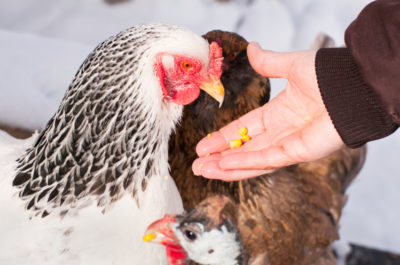
Prepare your chickens for colder temperatures
This time of year it is important to begin preparing your chickens and your coop for colder weather. In the Midwest, the popularity of winter-hardy breeds, is quite high. If you don’t keep them warm enough and well-fed, however, there’s a good chance that their egg production will drop off or stop altogether. By taking steps to winterize your coop before winter sets in, you can easily keep your chickens happy, healthy, and laying.
Winterizing The Coop
In every survival situation, finding good shelter is paramount, for both humans and animals, including chickens. Illness or death resulting from exposure is perhaps winter’s greatest threat to a flock’s well-being. Preparing your chicken coop for the cold months ahead is one of the most important steps toward keeping the birds happy, warm and healthy. It’s important to provide a clean, warm and draft-free environment for your chickens to winter in.
Clean, Clean, Clean
A bit of fall cleaning will go a long way towards preparing the coop for winter. Take out all perches, dishes, removable nest boxes, and other accessories, and spend some time giving everything a good scrub. Use scrubbers and scrapers to get off all those stuck-on droppings and thoroughly wash everything with a commercial cleaner or a simple vinegar-water solution. Now is also a great time to inspect everything: are there any cracks in the dishes, or are the perches too worn down? Replace anything that’s in poor shape, and leave the rest out in the sun to dry.
Fortify
Before returning the perches and everything else to their place in the coop, take advantage of the extra space to perform a thorough inspection. The coop’s integrity will make all the difference in the cold months ahead.
While maintaining airflow is just as important in winter as it is in the summer, too much can allow drafts in the coop. To little airflow, however, or poor control of water leaks, can cause the humidity to rise, which could make your coop a breeding ground for parasites and disease. You want your coop to maintain a comfortable 40 to 60 percent humidity. During the winter, it isn’t just the weather that threatens your chickens; it is also the cold, hungry predators that may be bolder in their search for an easy meal when resources become scarce.
Some things to look out for during your coop inspection:
- Make sure the coop doors, hatches, and other openings are hinged correctly and can shut tight.
- Look for signs of leaking water, and make sure the roof is watertight. Replace the roofing if necessary.
- Watch out for openings, cracks, holes, and anything else that could let in a draft. Some hatches and vents might need to be sealed shut for the winter.
- Look out for signs of predators, and fortify any weak spots that you notice.
- If you have electricity running to the coop, inspect all wires, hardware, and outlets for frays or other damage.
- Check on the coop’s bedding. Are there any signs of mice or other rodents? Is the bedding clean enough to be top-dressed, or will it need replacing?
Bedding
Most flock owners find that it isn’t necessary to completely clean out and replace the coop bedding in the fall. In fact, the presence of manure and decomposing bedding creates heat and can actually help keep the coop warmer. If you do decide to replace the bedding, don’t worry – there will be plenty of time for manure to build up throughout the winter.
You don’t have to switch to a new kind of bedding for winter. The following make perfect bedding all year-round:
- Straw: Straw is easy to come by and works great on its own or mixed with other bedding types.
- Wood shavings: Aspen, pine, and other shavings are widely available, can keep the stench and bugs down, and make for great insulation. Just make sure the shavings are chicken-friendly.
- Shredded paper: It compresses and decomposes too quickly to be used exclusively as bedding. Shredded paper makes a great lining for nest boxes, adds extra insulation, decomposes just fine, and is often free (newspaper is best – avoid bleached, colored, or glossy paper).
Heaters
In the Midwest, Northeast, and other regions where winter temperatures regularly drop into the single digits or below zero, it’s a good idea to provide a source of heat in the coop. Extra heating is also important if you have cold-sensitive chicken breeds or large single-combed roosters, which are prone to frostbite. There are several ways to provide electrical heat to your chickens, including radiant heaters and heat lamps. If your coop is well insulated, it won’t take much to provide extra warmth. One 100W bulb usually does the trick. Whichever heat source you decide to use, make sure the wires are out of the birds’ reach and keep an eye out for signs of wear or damage. Heating panels or lamps should be kept in a corner to allow the chickens to escape the heat if they need to.
Nutrition
Staying warm takes a great deal of energy, so it’s important that chickens are kept well fed both before and during the winter. You can expect their caloric needs to increase by 10 percent or more in cold weather. As with the rest of the year, make sure your chickens have constant access to a quality chicken feed. To help keep them laying and help make them more able to handle the stresses of dropping temperatures, you can also add some extras to their diet. Feeding a little extra corn is often recommended, as is high-quality pecking foods like forage cakes. To help the birds bulk up a bit, you can also occasionally feed warm oatmeal. Many chicken owners also provide greens such as alfalfa, wheat grass, and lettuce. This can help keep the chickens happy and nourished until spring arrives and the birds can forage again.
Water
Chickens need constant access to clean water in the winter just as they do in the summer. If winter temperatures drop well below freezing and you dread trekking out to the coop to break ice first thing in the morning, consider investing in a simple water heater. The birds seem to enjoy the warm water, and you can have the peace of mind knowing that ice won’t be a problem. Like any electrical heat source, keep wires away from the birds, and periodically check for signs of damage.
As you prepare for winter, especially if this is your first winter with chickens, remember to relax! Chickens are surprisingly adaptable birds, and it’s fun to watch how well they handle winter’s chill.
References
https://www.backyardchickens.com/products/category/chicken-breeds?593%5B0%5D=Cold
https://www.thegardencoop.com/blog/2010/11/18/winter-chicken-coop-care-p4/#more-1204
https://www.examiner.com/article/winterizing-your-chickens-for-the-cold-winter-months


























